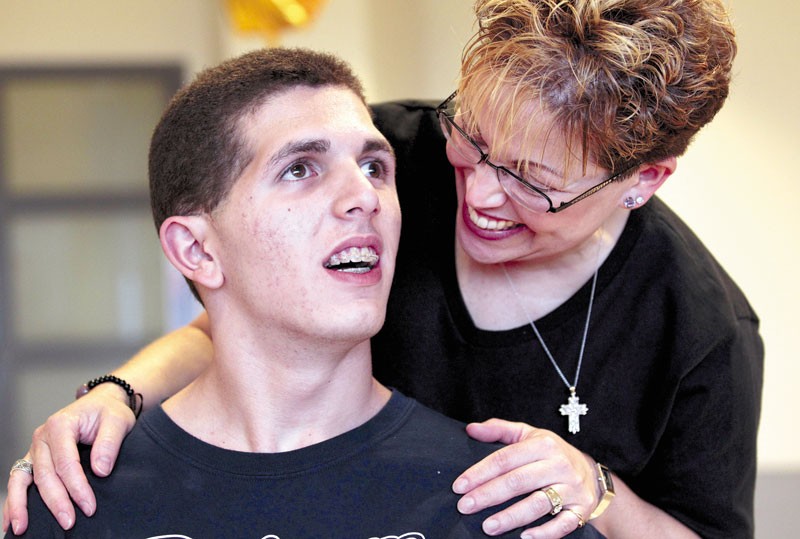
On a crisp October day in bucolic Maple Valley, Wash., Zach Lystedt took the field with his middle school teammates like they would for any other game. But this wasn’t just any other football game for Lystedt — or for the wider world of sports.
Lystedt, then 13 years old, suffered a concussion that went undetected; he returned to the action and played at full tilt for the entire second half. Just after the game, Lystedt lost consciousness and was rushed to the hospital. He ultimately needed two brain surgeries just to stay alive.
That was 2006, and as Lystedt’s story got out — all the way up to the Washington State Legislature and even the National Football League — it shook the way America thinks about concussions.
UNDERSTANDING THE INJURY
In the years since, concussions have continued to dominate sports headlines, even here in the Inland Northwest. Priest River football player Bobby Clark is only now back on his feet after the head injury he suffered last September. Gonzaga Prep and Washington State University product Steve Gleason has early-onset Lou Gehrig’s disease; some medical professionals think it can be traced to his years on the kickoff teams of the NFL. And even Super Bowl MVP Mark Rypien, who played at Shadle Park and WSU, has joined a lawsuit over brain damage suffered as a professional player that, the suit claims, has caused cognitive changes, dementia, depression and even led to suicide in former players.
To act on all that has been learned about the dangers, especially to young players who are more susceptible to concussions, a variety of interest groups are taking their message to the masses. There’s the STOP Sports Injuries campaign, and Safe Kids USA has expanded its efforts into concussions. The NFL has put a huge emphasis on preventing concussions, which, public health experts believe, will trickle down to all levels of football. Even the Centers for Disease Control has worked to convince parents and coaches to take head injuries more seriously. Fact sheets, brochures and videos are aimed at educating parents, coaches and players about the importance of following up on any forceful blow.
Barbara Brandon, associate director of Family Medicine Spokane’s sports medicine fellowship, says the public health campaign is working.
“Without a doubt, it is vastly improved,” Brandon says. “Before, it was hard to explain to people that if their kids were concussed they needed time out from activity. Nowadays families are much more willing to work with this.”
Spokane pediatrician Matt Thompson says it’s up to everyone — coaches, parents, other players — to be on the lookout. The rule, Thompson says, is that a kid who experiences a forceful blow to the head, or any kind of bump or jolt that results in rapid movement of the head, needs to be assessed. And concussions happen in all sports, with hockey, soccer and football being the biggest culprits.
Thompson recommends the PAR Concussion Recognition app available on smartphones. “That type of program is the only feasible way of really discerning more subtle cases, without going through in-depth testing. The main point is, we can’t take the chances we have been by getting kids back in or back to play too soon.”
And after the assessment, there needs to be continuing monitoring. “Never leave the athlete alone,” says Dr. Stanley Herring, a clinical professor in the departments of rehabilitation medicine, orthopedics, sports medicine, and neurological surgery at the University of Washington Medical School. Herring is also a team doctor for the Seattle Seahawks. “This is an injury you need to watch to make sure it doesn’t progress.”
Parents are also key to knowing how bad the damage is and when the athlete is better, says P.Z. Pearce, a Spokane doctor who owns Champions Sports Medicine and is the team doctor for the Spokane Chiefs.
One recent patient, a soccer player, came to Pearce’s office after her coach thought she was fine, but her mother didn’t. The girl’s mom had asked her if she wanted to go shopping and when she said no, her mom worried. It turned out the player did have a concussion and didn’t want to go because the noise and bright lights would have bothered her — two classic signs of a concussion.
“It’s really helpful to have a parent that’s savvy to the signs and symptoms of a concussion,” Pearce adds. “It’s those little, subtle things.”
AND IT’S THE LAW
Part of the reason people may be more willing to work with concussion guidelines is that they now have the force of law behind them — thanks to Zackery Lystedt. Though Lystedt survived that October day, what followed was every parent’s nightmare: coma, paralysis, three months in the hospital, nine months before he could speak, a year at a rehab center in Texas and 20 months on a feeding tube.
In 2009, Washington State passed the Zackery Lystedt Law, requiring any youth showing signs of a concussion to get medical clearance before being allowed back into practice or a game. Schools are also required to educate coaches, parents and young athletes about concussion risks, and get a signed consent form from parents and athletes.
Before the Lystedt Law, North Central High School head football coach Brian Gardner says deciding when a player should return to practice or a game wasn’t handled so carefully. It was usually left up to the team’s trainer, who works with the team throughout the season, he says.
“Now, with the law, it’s written and you have to follow that,” he says. “It’s pretty cut-and-dry.”
Still, Brandon, of Family Medicine Spokane, adds that “the downside [of the law] is that a lot of kids don’t want to report they have a concussion because they know they might not be able to play.”
BACK IN THE GAME
Greater awareness and even new laws are helping, but researchers and youth safety advocates are digging deeper. There’s been a lot of talk, for example, that better equipment could help.
West Bonner County Schools Superintendent Mike McGuire, who oversees the Priest River school where Bobby Clark played, says it’s naive to think football can be played without the impacts that cause concussions.
“We were very glad we had impact testing last year, and we’ll hope for less, or zero, concussions next year, but they’re playing football,” McGuire says. “Football is a sport where they go as hard as they can at each other.”
Researchers point out that helmets are not enough. Think of it this way: Though the helmet does protect the bony skull, when the head rapidly accelerates and decelerates, the brain still fl ops around inside its hard shell of bone. It’s that impact, inside the skull, that causes concussions.
“There’s no helmet right now that will prevent concussion,” says Kevin Guskiewicz, a University of North Carolina researcher and consultant with the NFL. “They do a wonderful job preventing catastrophic outcomes, they help with concussion, but they don’t prevent concussion.”
Training players to avoid the most damaging hits to the head could help, too. Elite players are being individually monitored and taught new tackling techniques in Guskiewicz’s University of North Carolina lab. The NFL has also stepped up penalties and fines for blows to the head.
Still, the fact that research is showing there’s no “safe” number or “acceptable” level of concussion has left some to question the ethics of a game like football. Malcolm Gladwell, author of The Tipping Point and Outliers, has observed that “some percentage of people are going to die prematurely [playing football]. Quite prematurely.” Gladwell predicted to the New York Times last month that in 15 years or so, no reasonable person will admit to watching football.
Others are sounding alarm bells, too. Dr. Dan Cantu is the co-director of the Center for the Study of Traumatic Encephalopathy at the Boston University School of Medicine. He was one of the first medical professionals to start warning about concussions back in 2000. He recently made headlines when he advised that no children under the age of 14 — none, zero — be allowed to play collision sports in the manner they are currently played.
“We have millions of youngsters putting their heads into collision sports right now,” Cantu told Boston’s WCVB-TV, “and we don’t really know how safe this is for them.”
CHANGE IS COMING — SLOWLY
Roger Goodell, the commissioner of the NFL, is listening. His high-profile, multi-billion-dollar league has been thrust into a leadership role on this public health issue. Goodell has pushed states to adopt laws like the one passed in Washington. Today, all but five states have passed similar laws or have one pending. Still, for health advocates and families who have suffered injuries, even those laws could be more stringent.
Last spring, Zach Lystedt graduated from Tahoma High near Maple Valley. His speech is slow, his short-term memory spotty, but he’s gone 200 steps without his cane and is taking college classes.
“Our challenge,” Goodell told the Associated Press last June, “is to match Zach’s determination and persistence.”
What is a Concussion?
When the spongy human brain bounces into the skull as a result of any hard hit, that’s a concussion. Sometimes minor bumps to the head or jars to the entire body can result in a concussion. Other times, players walk away from a serious hit unfazed.
Doctors still don’t fully understand how a concussion happens, but they know it causes an “electrical phenomenon in the brain,” says P.Z. Pearce, the team doctor for the Spokane Chiefs who sees patients with concussions.
Normally, about 3 percent of cells in the brain are “firing” at any given time, but when the brain takes a hit, up to 40 percent of them can become active, Pearce says. At the same time, the cells become deprived of glucose. Although the concussed brain would appear normal on a CT scan, cells in the affected areas aren’t functioning properly, leading to changes in cognition and balance.
“The biggest misconception among athletes themselves is that they’re indestructible,” Pearce says, “and that it’s no big deal to have a concussion.”
Another misconception, discussed by Kevin Guskiewicz in a December lecture at a North Carolina symposium on brain injury, is that “far too many individuals, coaches, parents, players, physicians — I will add physicians to the list — still think that if you haven’t lost consciousness, then you’ve not sustained a concussion.”
Guskiewicz, a researcher and consultant with the NFL’s committee to reduce concussions, adds “less than 10 percent of all concussions involve any loss of consciousness.”
The most noticeable symptoms of a concussion are feeling dazed or confused, answering questions slowly, having trouble remembering what happened before or after the event, showing any sort of personality or behavior changes, or losing consciousness, even briefly. More serious effects are decreased coordination, vomiting and slurred speech.
But when symptoms have resolved — sometimes taking as long as a month or even a year — activity can gradually resume, ramping up on successive days as long as symptoms don’t return.
In spite of increased concussion awareness, the Nationwide Children’s Hospital Research Institute found that 40 percent of concussed high school athletes returned to play too soon. In high school football, almost 16 percent of players returned to a game the very same day they suffered a concussion.
New discoveries about brain development reveal why returning to sports before the brain has fully healed is an especially bad idea. Younger brains that are still developing, especially between ages 10 and 18, are especially susceptible to re-injury, Pearce says. Kids who have already had a concussion are more vulnerable to a second concussion and at risk for post-concussion syndrome, in which the concussion symptoms return, or worsen. More serious is second-impact syndrome, in which a repeat injury causes rapid swelling of the brain. Fatal in fully half of the kids who experience it, second-impact syndrome causes permanent brain damage in those who survive it.
There’s no quick fix for a concussion. “You can’t ice your head, it doesn’t work,” Dr. Stanley Herring, a clinical professor at the University of Washington Medical School, told graduating medical students in 2008. “There’s no short cut. The recovery is purely based on time.”



















